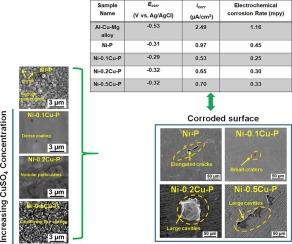Influence of Cu addition on the microstructure, and corrosion behavior of electroless Ni-Cu-P coating on squeeze-cast Al-Cu-Mg alloy
IF 5.3
2区 材料科学
Q1 MATERIALS SCIENCE, COATINGS & FILMS
引用次数: 0
Abstract
Electroless nickel‑phosphorus based (ENP) coating on Al alloys offers superior mechanical, and tribological properties conferring resistance against corrosion. Further, the inclusion of copper in the ENP coating can improve the thermal stability and surface passivation. The present work explores the effect of a gradual increase in cupric sulfate (0.1, 0.2, and 0.5 g L−1) concentration on the microstructural evolution and corrosion behavior of squeeze-cast Al-Cu-Mg alloy in NaCl solution while maintaining the nickel-phosphorous bath parameters viz., pH, temperature, and deposition time unchanged. The phase, microstructure, and tribological analysis show that 0.1 gL−1 CuSO4 addition is optimal, providing a few microns thick, smooth, and compact coating of nodular particulates demonstrating the highest microhardness (∼314 ± 7 HV0.05) and scratch resistance (Hs ∼930 MPa). However, further increasing the Cu2+-ions concentration beyond 0.1 g L−1 changes the morphology to a cauliflower-like nodular structure consisting of surface heterogeneities with low microhardness and high surface roughness owing to the softening of deposited Cu particles. Potentiodynamic measurements and electrochemical impedance spectroscopy results show that Ni-0.1Cu-P specimen exhibits lowest corrosion current density (icorr ∼0.53 μA cm−2), and the highest charge-transfer resistance (Rct ∼5.64 × 104 Ω.cm2), among entire specimens owing to the formation of dense, granular structure with high P (∼12.34 wt%) and low Cu (∼1.5 wt%) content. The Mott-Schottky analysis of Ni-0.1Cu-P specimen confirms the formation of p-n type bipolar semiconductor passive films blocking the movement of anions with lower donor carrier density (Nd ∼1.46 × 1019) preventing the passive films breakdown and providing better corrosion resistance.

添加铜对挤压铸造铝-铜-镁合金无电解Ni-Cu-P涂层的微观结构和腐蚀行为的影响
铝合金上的非电解镍磷(ENP)涂层具有卓越的机械和摩擦学性能,并具有耐腐蚀性。此外,在 ENP 涂层中加入铜可以提高热稳定性和表面钝化效果。本研究探讨了在氯化钠溶液中逐渐增加硫酸铜(0.1、0.2 和 0.5 g L-1)浓度对挤压铸造铝-铜-镁合金的微观结构演变和腐蚀行为的影响,同时保持镍磷镀层的 pH 值、温度和沉积时间等参数不变。相位、微观结构和摩擦学分析表明,0.1 gL-1 CuSO4 的添加量是最佳的,它能提供几微米厚、光滑、致密的结核颗粒涂层,显示出最高的显微硬度(∼314 ± 7 HV0.05)和抗划伤性(Hs ∼930 MPa)。然而,当 Cu2+ 离子浓度进一步增加到 0.1 g L-1 以上时,由于沉积的 Cu 颗粒软化,其形态变为由表面异质性组成的菜花状结节结构,微硬度低,表面粗糙度高。电位测量和电化学阻抗谱结果表明,Ni-0.1Cu-P 试样的腐蚀电流密度最低(icorr ∼0.53 μA cm-2)和最高的电荷转移电阻(Rct ∼5.64 × 104 Ω.cm2 ),这是由于高 P(∼12.34 wt%)和低 Cu(∼1.5 wt%)含量形成了致密的粒状结构。对 Ni-0.1Cu-P 试样进行的 Mott-Schottky 分析证实,p-n 型双极半导体无源薄膜的形成阻止了阴离子的移动,而较低的供体载流子密度(Nd ∼ 1.46 × 1019)则防止了无源薄膜的破裂,并提供了更好的耐腐蚀性。
本文章由计算机程序翻译,如有差异,请以英文原文为准。
求助全文
约1分钟内获得全文
求助全文
来源期刊

Surface & Coatings Technology
工程技术-材料科学:膜
CiteScore
10.00
自引率
11.10%
发文量
921
审稿时长
19 days
期刊介绍:
Surface and Coatings Technology is an international archival journal publishing scientific papers on significant developments in surface and interface engineering to modify and improve the surface properties of materials for protection in demanding contact conditions or aggressive environments, or for enhanced functional performance. Contributions range from original scientific articles concerned with fundamental and applied aspects of research or direct applications of metallic, inorganic, organic and composite coatings, to invited reviews of current technology in specific areas. Papers submitted to this journal are expected to be in line with the following aspects in processes, and properties/performance:
A. Processes: Physical and chemical vapour deposition techniques, thermal and plasma spraying, surface modification by directed energy techniques such as ion, electron and laser beams, thermo-chemical treatment, wet chemical and electrochemical processes such as plating, sol-gel coating, anodization, plasma electrolytic oxidation, etc., but excluding painting.
B. Properties/performance: friction performance, wear resistance (e.g., abrasion, erosion, fretting, etc), corrosion and oxidation resistance, thermal protection, diffusion resistance, hydrophilicity/hydrophobicity, and properties relevant to smart materials behaviour and enhanced multifunctional performance for environmental, energy and medical applications, but excluding device aspects.
 求助内容:
求助内容: 应助结果提醒方式:
应助结果提醒方式:


